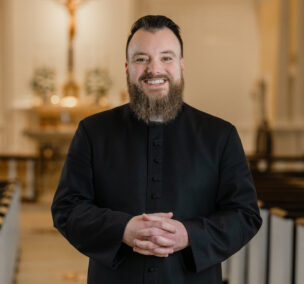Dear Brothers and Sisters in Christ,
The forty days of Lent, with their liturgical sobriety and penitential character, may make the Gospel story of the Transfiguration of Jesus seem an odd choice for the Church. After all, these days of prayer, fasting, and almsgiving are a season of repentance, a season when the Gloria is not sung, when our celebrations bear the marks of penitence and simplicity. Yet in this Gospel, the glory of the Lord is on full display, and Peter is ready to stay on the mountain basking in the radiant light. Though it may seem off-theme, it is the passage’s end (and the stories immediately preceding and following) that give us the Lenten context.
Immediately before the Transfiguration, the Gospel of Luke tells us of Peter’s great confession of faith. Jesus asks the Apostles who people say He is, and Peter answers “The Christ of God” (Lk. 9:20). After this, Jesus reveals to the Apostles that He is to go to Jerusalem and suffer and die, and on the third day be raised. While Luke’s Gospel does not include this detail, the Gospels of Mark and Matthew famously tell of Peter’s offense at the idea that his Lord would have to suffer. He pulls Jesus aside and rebukes Him. In haunting words, the Lord says in reply, “Get behind me, Satan. You are thinking not as God thinks, but as men think.” Luke, however, simply moves from the account of Peter’s confession of faith and Jesus’ revelation about his future suffering and death into the story of the Transfiguration.
Immediately after the Transfiguration, Luke recounts the healing of a boy possessed by a demon. Just after they come down the mountain from the incredible vision of Moses and Elijah conversing with Jesus, they encounter a large crowd and a father in distress. The Apostles had tried to cast the demon out from this man’s son without success. Jesus heals the boy and restores him to his father. “And all were astonished at the majesty of God” (Lk. 9:40).
This broader reading of Luke gives us the framework in which to understand our Lenten context. First, Peter professes his belief in Jesus. With great excitement, with great reverence, he affirms his heartfelt belief that Jesus is the Messiah, the one sent to save Israel. Then, on the mountain, Peter (after being overcome by sleep) sees Jesus transfigured and his faith is confirmed as he hears the voice of God saying, “This is my Son.” The Transfiguration Gospel ends with the light disappearing and the Apostles standing with Jesus alone, before they go back down the mountain, back to the noise and chaos of daily life. As Lent began, we were called to a renewal in faith. Remembering that we are dust and to dust we shall return, we were told to repent and believe in the Gospel. There is a reward for our faith, just as there was a reward for Peter’s faith: we are invited up the mountain to witness the glory of the Lord. The mountain for us is our worship every Sunday at Mass, the high point of the week. Finally, like the disciples, we will go back down the mountain, back to our world of confusion, doubt, and suffering. Yet even there, Jesus wants to work miracles. Each of these moments is important for our observance of this holy season of Lent.
Faith precedes all. In the sacrament of Baptism, we were given the gift of faith. Some grow in their faith with the help of their parents and godparents. Others come to faith because of an inspiring teacher, or a friend who witnesses to them of the power of God in their lives. Somehow, our hearts are moved to say “yes” to Jesus, to His teachings, and to His presence in our lives. The act of faith becomes the foundation for everything else we will do. In the ordinary course of events (extraordinary interventions into the lives of individuals such as that experienced by St. Paul on the road to Damascus being the exception), it is our faith in God that enables us to have the mountain-top experience of the transfiguration. Because we believe, we are able to encounter Him at Mass, in the Eucharist, in the truly sacred and consecrated space of the church building. From the greatest of cathedrals to the humblest parish church, these buildings are meant to be the place of Transfiguration. It is a place of encounter, a place where our faith is confirmed, a place where God speaks to us in the Scriptures and in the sacraments. At each Mass, we are meant to get a glimpse of the glory of God. Then, having been confirmed in faith, having received the word, having peeked into heaven, we are sent back down the mountain. Going down the mountain, we inevitably come up against the difficulties of the world. We confront our own failures and the failures of others. When we begin to recognize God’s action in our world, we also come to an awareness that God meets us both in the Mass and in our daily lives.
The Transfiguration was a moment that Peter wanted to hold on to for as long as possible. It was also a prefiguration of the future. The sleep of the Apostles while Jesus was praying prefigures their sleep in the Garden of Gethsemane. The glory witnessed on the mountain prefigures the glory of the Resurrection and the eternal glory we will behold in Heaven. These forty days of Lent also help us to experience God’s presence here and now, while at the same time looking forward: we look ahead to the celebration of the Easter mysteries in a few weeks, and we turn our minds and hearts to the reality of our hope for Heaven and the coming again in glory of our Lord. In these days, we are invited up the mountain, especially on Sunday, to experience the closeness of God. Our Lenten disciplines help us to stay in the moment, to metaphorically build tents. Those same disciplines help us as we go back down the mountain. If Sunday is meant to be the high point and the day of transfiguration for us each week, it is our Lenten disciplines that help us walk with Jesus and invite His healing into their lives. Today we gather at the altar, at the mount of the Transfiguration, and with Peter, we make our confession of faith. If we are to be truly faithful, it is necessary for us to go down the mountain. May our Lenten disciplines help us this week to invite Jesus into our days, to experience His healing power, and to remember our desire not only for immediate spiritual satisfaction, but for the lasting peace of eternal salvation.
Peace,
Fr. Sam


